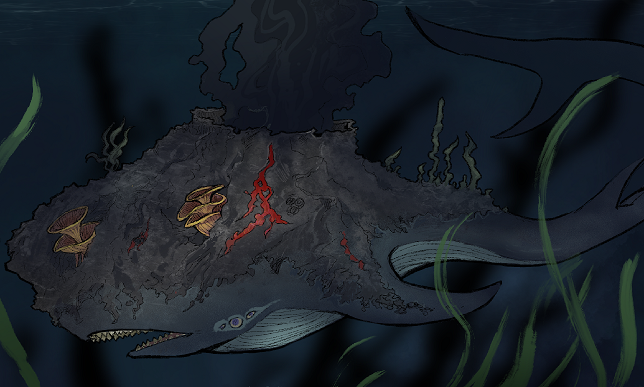Broadsnout Whales
Basic Information
Anatomy
The hard shell atop a Broadsnouts back is the result of tar hardening and forming dense layers. These build-ups eventually become home to corals and reefs as time goes by and the whale goes larger. Within the centre is an almost volcanic appearing outcrop, thick black tar pouring from the top. This tar - paired with currents produced by specialised air-vents within its back - forms a whirlpool barely noticable on the Ocean Below until it's far too late.
Growth Rate & Stages
While the sizes of a Broadsnout will vary from sailor to sailor, it's a well known tale that the majority of Southmarch was constructed using only one whale bone. Whales of that size have never been reported in present times, though there are plenty of tales about them.
Ecology and Habitats
The Broadsnoat is found in the open waters of the Ocean Below. Typically circulating the natural currents, they spent the majority of their time swimming along the bottom of the Ocean Below, waiting for food to be dragged by the tar to them.
Dietary Needs and Habits
The Broadsnout Whale is an omnivore; it digests plant and meat matter sucked into the tar-hole from its' back, and any indigestible material is often secreted through its' back.
Additional Information
Perception and Sensory Capabilities
A Tar-Whale has three eyes, though its vision is poor. It's claimed their vision is adapted to seeking out arcane-imbued matter rather than physical details of the ocean floor due to reflections found in autopsies of eyes, but it's unknown just how much the Broadsnout can or cannot see.
Scientific Name
Tar-whales.
Conservation Status
Tar Whale Whirlpools are common to find across the Ocean Below, but rarely do the whales come up from the bottom of the Ocean. Often the larger ones are weighed down by the building of coral on their backs; regardless, the smallest is roughly ten times the size of the common blue whale found upon the Surface, so people don't tend to be concerned about how many numbers there are as much as steering clear of any and all sightings.
Remove these ads. Join the Worldbuilders Guild












Comments